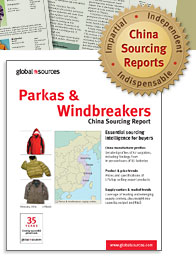|
Sample pages |
| Executive summary | Industry overview | Supplier profile | Product gallery | ||||
| China
suppliers of parkas and windbreakers are raising
prices by up to 15 percent and taking measures to
enhance efficiency in response to the continuing
increase in raw material costs and the ongoing labor
shortage. A number of makers are also taking steps
to improve product quality.
One of the most pressing challenges in the industry at present is the soaring cost of raw materials. The majority of fabric and accessories used to make the jackets are petroleum-based. With fluctuating crude oil prices in the world market, the cost of these materials has increased by as much as 30 percent in the past year. The labor shortage affecting industrialized provinces in China is also a major challenge. The shortage, which was initially limited to Guangdong province, is now also widespread in the provinces of Fujian and Zhejiang, the main production hubs for jackets. In fact, a number of factories in these areas have only half of their required permanent workforce at any given time, since most workers prefer to work on a temporary basis. The problem is further aggravated by the large number of suppliers in this industry. Many skilled workers are enticed by companies that offer higher salaries and better benefits. Manufacturers are thus forced to match such job offers with higher pay, better housing and training for their employees, consequently raising operating costs. The lack of skilled workers has also forced many companies to increase subcontracting up to 30 percent to other jacket-producing makers in their area to meet delivery schedules. They often subcontract to factories producing for the domestic market, and while most companies are able to get workers when they need them, doing so has pushed up operating costs even higher. The situation may also lead to scheduling and quality problems, since makers have less control over production. Because of these factors, makers have no choice but to increase prices in coming months. While most suppliers will raise quotes by up to 5 percent, a handful of companies plan increases of as high as 15 percent. To boost competitiveness, a number of companies are now shifting focus to the production of value-added models. These jackets have functional treatments and are designed for increased comfort and durability. Although these are priced 20 to 50 percent more than regular designs, there is less competition in the line. The most significant of improvements is in water-resistance levels of fabric. The most popular types have a water-resistance rating of 2,000 to 5,000 mm. But some suppliers now offer designs with ratings ranging from 8,000 to 20,000 mm. In addition, many companies are producing parkas and windbreakers made of high-performance materials such as Drilon, Entrant, Dermizax, Supplex and Thinsulate that are imported from the US and the EU. Industry composition And more... To see the full Industry Overview
order now.
|
|
|||
|
|
|
|
| All information contained in China Sourcing Reports is the result of original, independent and impartial research conducted by Global Sources analysts. Apparel Search is working in association with Global Sources to help promote this sourcing report to the international fashion community. If you have questions about the report or status of your orders, please e-mail Xue Mei for further assistance. |
| The Parkas and Windbreakers report has been developed and maintained by Global Sources. Apparel Search is working in association with Global Sources to help promote this sourcing report to the international fashion community. |
Apparel Search
Add Your Company
Contact
Us About Us
Advertise
News Letter
Legal
Help
Copyright © 1999-2023 Apparel Search Company.
All Rights Reserved.



